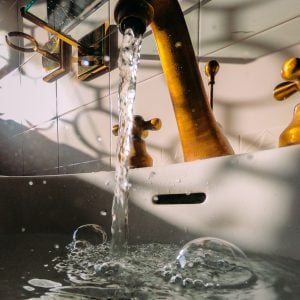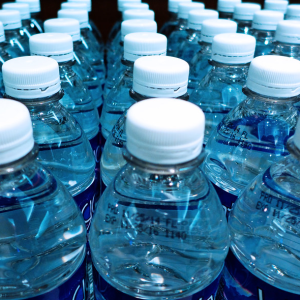Brew With Us ESSENTIALS – sourcing your water

Liquor or not, it’s water under the bridge
Before we get anywhere near adjusting or treating your water, we need to know what we’re starting with.
Let’s head to the source…
Brewers call water that will be used to make beer “liquor”. This is to distinguish it from any other kinds of water in the brewery, such as untreated water used for cleaning.
The most obvious source of liquor for homebrewing is your domestic tap. Bottled mineral water is another common choice. Some people even have their own wells or springs, but this is a rare luxury!
The difference between all these sources of water is in the minerals. All water is “mineral” water unless it’s distilled to remove the compounds dissolved in it. This is a good thing for us brewers as those minerals are often good for making beer, and if they weren’t there we would have to add them back in.
Tap water

A lot of homebrewers use tap water – equally, many choose not to because their domestic supply is not nice to drink. Even if the water in your area generally tastes good, some houses have water softeners built into the mains supply, which can leave a salty flavour. If you don’t like the taste of your tap water, you are better off using another source for brewing.
If you do like the taste of your home water, there are several advantages to using it. Collecting your liquor is as easy as opening a tap, and the rates are very low compared to other sources of water. There is also something to be said for local variations: your beer will taste of your area, perhaps even your particular street or house. For some brewers, this is an important character and a connection to where they live.
When using tap water for brewing, it’s a good idea to get an individual water report. Murphy & Sons offers an affordable homebrewing water analysis service: just send them a small sample and they will give you a targeted report on your water. Getting a water report specific to your home means you know exactly what’s coming out the tap you use for your brewing.
The Murphy & Sons report include lots of different measurements, including all the key values we’re interested in for brewing:
- Calcium (chemical symbol Ca)
- Magnesium (Mg)
- Sodium (Na)
- Sulphate (SO4)
- Chloride (Cl)
- Alkalinity (also labelled as bicarbonate, usually measured as CaCO3)
- pH
We’ll go through what each of these means in the next chapters, so for now just make a note of these numbers. They will be measured in ppm or mg/l – either is fine – and pH will be a number to two decimal places, e.g. 7.14 (the reading here at The Malt Miller HQ).
An alternative to an individual report is to get hold of a generic water report from your supplier. All water companies in the UK will provide free water reports. You can often find these by looking for “water quality” on their websites. They are usually updated at least once a year, so make sure you get the most recent report. These will include dozens of other measurements in addition to the key values listed above, so you might have to do some combing through.
Local water reports can be less accurate than individual tests; any filtration or softening systems in your house will mean the water from your tap won’t match your local ground water, as can everything right down to the age of the pipes supplying you.
The majority of domestic water supplies have chlorine (or a similar compound, chloramine) added to kill harmful bacteria. You can even smell this in the water sometimes! Both chlorine and chloramine can produce bad flavours in beer, even when they are only present in tiny amounts, so it is a good idea to remove these.
You can do this fairly simply by adding sodium metabisulphite, also known as Campden. 0.25g of sodium metabisulphite is enough to treat 25L of water and won’t leave any flavour of its own. The process isn’t instant, so it’s a good idea to collect and treat your brewing liquor at least a few hours before you begin brewing – the night before is ideal.
Bottled water
Using bought bottled water is a simple alternative to tap water, though it will cost a bit more. Just as with tap water, there are some mineral measurements we’re interested in – these are usually listed on the label. Each brand of water will vary in mineral content, and sometimes the same brand can change between batches, so it’s worth checking the label regularly.
Most bottled waters don’t contain high levels of chlorine, if any at all, but you might choose to add sodium metabisulphite just in case. The dosage rate is the same – 0.25g for 25L of liquor.

Reverse osmosis

You can purify your tap water with a process called reverse osmosis (RO). This removes virtually all the minerals from your water as well as the chlorine. You can then add your own minerals back in to get the balance you prefer (more on mineral balance in a later chapter).
It’s important to add minerals back to RO water because without them it is extremely bland – so much so that it is virtually tasteless. This might sound good on paper, but in practice it also means your beer will be bland!
There are several advantages to RO systems. The purified water they produce is effectively a “blank slate”, allowing you to very precisely dial in your preferred mineral balance. They are also highly consistent – while bottled water and domestic tap water can vary over time, RO water should always be the same. This vastly improves the repeatability of your brewing.
The downside is that RO systems are more expensive upfront than bottled water, though if you brew often you may find the system pays for itself. The filtration components also need to be replaced every now and again, though they will usually last for many thousands of litres. RO systems also waste some water: typically 3L of waste water is produced for each 1L of purified water. Some brewers use the waste water for cleaning to reduce the environmental impact.
Producing purified water takes time, and different systems run at different speeds. You may find it’s a good idea to start running your RO system to collect your brewing liquor the night before you brew. Check your particular system to work out how long it will take to produce the right amount of liquor.
A little seasoning
A little more sulphate in your IPA, or would you prefer some chloride?
Find out if you’ve got the minerals to make your best beer…


